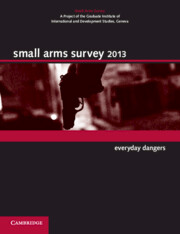Book contents
- Frontmatter
- Foreword
- Contents
- About the Small Arms Survey
- Notes to readers
- Acknowledgements
- Introduction
- Chapter 1 Everyday Dangers: Non-conflict Armed Violence
- Chapter 2 Too Close to Home: Guns and Intimate Partner Violence
- Chapter 3 Turning Points: Gang Evolution in Nicaragua
- Chapter 4 Guns in the Family: Mafia Violence in Italy
- Chapter 5 Survival at Stake: Violent Land Conflict in Africa
- Chapter 6 Trend Lines: Armed Violence in South Africa pages 132 to 137
- Chapter 6 Trend Lines: Armed Violence in South Africa pages 137 to 159
- Chapter 7 Second Wind: The PoA's 2012 Review Conference pages 160 to 168
- Chapter 7 Second Wind: The PoA's 2012 Review Conference pages 169 to 177
- Chapter 8 Trade Update: Authorized Small Arms Transfers
- Chapter 9 Burning the Bullet: Industrial Demilitarization of Ammunition pages 186 to 199
- Chapter 9 Burning the Bullet: Industrial Demilitarization of Ammunition pages 200 to 217
- Chapter 10 ‘Infernal Machines’: Improvised Explosive Devices
- Chapter 11 Price Watch: Arms and Ammunition at Illicit Markets pages 250 to 268
- Chapter 11 Price Watch: Arms and Ammunition at Illicit Markets pages 269 to 281
- Chapter 12 Captured and Counted: Illicit Weapons in Mexico and the Philippines pages 282 to 302
- Chapter 12 Captured and Counted: Illicit Weapons in Mexico and the Philippines pages 302 to 317
- Index
Chapter 9 - Burning the Bullet: Industrial Demilitarization of Ammunition pages 186 to 199
Published online by Cambridge University Press: 05 June 2014
- Frontmatter
- Foreword
- Contents
- About the Small Arms Survey
- Notes to readers
- Acknowledgements
- Introduction
- Chapter 1 Everyday Dangers: Non-conflict Armed Violence
- Chapter 2 Too Close to Home: Guns and Intimate Partner Violence
- Chapter 3 Turning Points: Gang Evolution in Nicaragua
- Chapter 4 Guns in the Family: Mafia Violence in Italy
- Chapter 5 Survival at Stake: Violent Land Conflict in Africa
- Chapter 6 Trend Lines: Armed Violence in South Africa pages 132 to 137
- Chapter 6 Trend Lines: Armed Violence in South Africa pages 137 to 159
- Chapter 7 Second Wind: The PoA's 2012 Review Conference pages 160 to 168
- Chapter 7 Second Wind: The PoA's 2012 Review Conference pages 169 to 177
- Chapter 8 Trade Update: Authorized Small Arms Transfers
- Chapter 9 Burning the Bullet: Industrial Demilitarization of Ammunition pages 186 to 199
- Chapter 9 Burning the Bullet: Industrial Demilitarization of Ammunition pages 200 to 217
- Chapter 10 ‘Infernal Machines’: Improvised Explosive Devices
- Chapter 11 Price Watch: Arms and Ammunition at Illicit Markets pages 250 to 268
- Chapter 11 Price Watch: Arms and Ammunition at Illicit Markets pages 269 to 281
- Chapter 12 Captured and Counted: Illicit Weapons in Mexico and the Philippines pages 282 to 302
- Chapter 12 Captured and Counted: Illicit Weapons in Mexico and the Philippines pages 302 to 317
- Index
Summary
States procure more conventional ammunition than they use. To avoid depot congestion with obsolete ammunition and to reduce storage costs, they dispose of part of their stockpiles via foreign military sales and increase the use of ammunition for training purposes. Despite these disposal initiatives, a large part of a nation's surplus ammunition stockpile will ultimately require demilitarization—a process by which ammunition is safely dismantled or destroyed while, ideally, its valuable materials are recovered.
In many countries, excess stockpiles of obsolete or unserviceable munitions have reached a level requiring demilitarization on an industrial scale, often in a race against time as the ammunition tends to become unsafe with age. Since states rarely have the capacity to demilitarize the surplus ammunition stockpiles of their collective security forces, they often turn to the demilitarization industry.
Policy-makers and programmers tend to be poorly informed about the demilitarization industry's markets, challenges, and techniques, for several reasons. Data pertaining to ammunition demilitarization is just as sensitive as ammunition design and procurement information. Hence, policy-relevant information is rarely distributed publicly and resides predominantly within individual ministries of defence (MoDs), their contractors, and some international bodies such as NATO ammunition working groups. Furthermore, contractors fear that discussing their activities and capacities publicly may put them at a commercial disadvantage. Finally, academia has not traditionally covered this activity.
- Type
- Chapter
- Information
- Small Arms Survey 2013Everyday Dangers, pp. 186 - 199Publisher: Cambridge University PressPrint publication year: 2013



